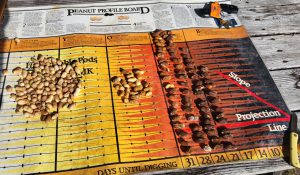Mark Mauldin, Ag & Natural Resources Agent Washington County, Ethan Carter, Regional Row Crop IPM Agent,
I started out the previous peanut maturity update by declaring that we had officially made it to Fall, and in a pleasant change of pace the weather actually reflected the calendar. At the time I was spinning that as a positive (the weather really has been lovely for for the past couple weeks), unfortunately the cooler and drier conditions we associate with Fall have had anything but a positive effect on our later planted peanut fields. Fields are maturing VERY SLOWLY right now and the even cooler temperatures expected this weekend will only slow them down more.

This sample came from a field planted 143 days ago. Note the “days until digging” indicated on maturity board. This is probably the most delayed field I’ve seen a sample from this year, with optimum maturity predicted at over 160 DAP. Photo Credit: Mark Mauldin
Field maturity has been all over the board this year. With the exceptional amount of heat we had earlier in the season, irrigated fields matured very rapidly while drought stress slowed rain-fed fields down considerably. Many of the same rain-fed fields that drought has already delayed are now feeling the compounding effects of cooler temperatures. Collectively, this means we have seen (via maturity board results) fields in the Central Panhandle track 10+ days ahead to 14+ days behind the 140 day rule-of thumb. Fields that have been maturing slowly will fall farther behind schedule with continued dry conditions and coming cooler weather.
–
What does all of this mean?
Put briefly, it means harvest timing decisions for many later planted, rain-fed fields will be based on vine condition and not strictly crop maturity. The way things are trending right now, mid-May planted rain-fed fields will likely take close to 160 calendar days to reach optimum maturity based on accumulated aGDDs. That’s a long time to keep peanut vines alive, particularly in light of the challenging growing season they’ve already been through. Based on data from peanutFARM.org, reflected in the aGDD Tracker below, rain-fed fields in the Panhandle have accumulated approximately 12 aGDDs per calendar day over the past two weeks. This is down from the 18+ aGDDs per calendar day that were being accumulated earlier in the growing season with a further decline expected.
Disease management is/will be crucial to holding fields together long enough to reach optimum maturity. Cooler weather is unfavorable for white mold and will slow its development and spread. This disease has been one that many growers have struggled with this year, some fields had obvious symptoms during the season, while others were only obvious at digging when major yield losses were evident. Leafspot will continue to spread and be an issue even with the cooler weather and will need to be managed accordingly.
Even with a solid disease management program, fields will not last forever. Conversations with growers this week have boiled down to “delay digging as long as you can (for the sake of better yield and grade) but don’t risk the crop by waiting too long“. If a field’s canopy has defoliated 50% it’s likely time to dig. Dig immediately once a field is 75% defoliated.
aGDD Tracker for the Florida Peanut Producing Region – 10/6/23 edition
The aGDD Tracker is compiled from data generated by PeanutFARM.org. The dark blue bars in the cells with the aGDD values indicates progress towards 2500 aGDDs. The bar extends to the right as aGDDs are accumulated. The entire cell will be dark blue when a field has accumulated 2500 aGDDs. It is recommended that fields be sampled and exact days-to-harvest be determined via pod-blasting once a field reaches 2300 aGDDs.
- Improve Your Pasture Management this Spring - April 19, 2024
- Plant Now for the Panhandle Watermelon Festival Big Melon Contest & New Junior Jubilee Kid’s Contest - March 8, 2024
- Central Panhandle Pesticide Applicator Training Series – February 12-15 - January 19, 2024
